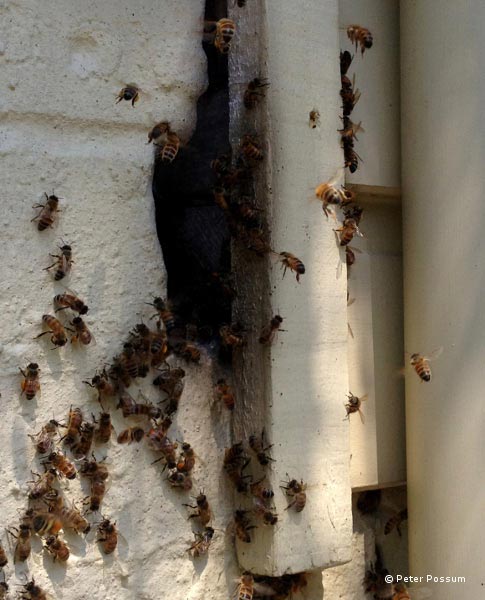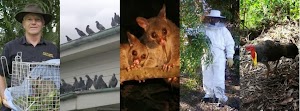1. ANIMAL DESCRIPTION
Common name: Honey Bee or Western Honey Bee
Scientific name: Apis mellifera
Fact: The genus Apis means bee in Latin. Mellifera is also derived from the Latin words melli “honey” and ferre “to bear”. This led to the scientific name translating as “honey-bearing bee”. The original Latin name was created by a famous early scientist, Carolus Linnaeus in 1758. Once Linnaeus realized the honey bees produced nectar – not honey, he tried (but failed) to correct his error and change the bees Latin scientific name to “Apis mellifica”, meaning the honey-making bee.
SIZE
Adult size of the drone bee when fully grown is 130mm to 160mm. The queen of the colony is much larger than this depending on how old the queen may be.
FEATURES
They are the most commonly domesticated bee species in the world. They usually have dark base colourings of brown with a banded dull yellow and brown abdomen. The head, thorax and abdomen and legs are densely covered in hair.

Feral Bees
2. ECOLOGY AND BEHAVIOUR
They have been in Australia for approximately 150 years. Managed bee hives form the basis of an industry that provides significant crop pollination services around Australia.
The main benefit humans receive is the farming of their honey for human consumption. It is a very large industry. Honey is the complex substance made by bees when the nectar from flowers and other sweet deposits from plants and trees are gathered, modified and stored in the honeycomb in the bee hive.
It is a complex biological mixture that consists mostly of inverted sugars, primarily glucose and fructose. It has antibacterial and antifungal properties and will not rot or ferment when stored at room temperature. However honey will crystallize with time. Bees can only eat honey in its liquid form.
Feral Bee Colonies
When a queen escapes from a managed bee hive, she takes many of the workers with her; she can start a new colony anywhere and without the benefit of humans managing the hive, the new problem bee colony is usually referred to as “feral”.
They will compete with native fauna for floral resources and may disrupt the natural pollination processes, especially for native flowers. They will displace Australian wildlife from tree hollows where the native animals nest and hide from predators. The feral bee creates its hives in the hollows and no animal can share its den with an active bee hive due to being repetitively stung by the bees. Since a natural tree hollow will typically not develop in a gum tree until it is 70 or more years old, hollows are very scarce and so the existence of feral bee swarms is a significant threat to any native animals that need tree hollows for their survival.
Communication
Honey bees communicate through the language of dance. They are able to direct other bees from their hive to new food sources that they have discovered by signalling with their round dance and waggle dances.
The round dance tells the other workers the food source is within 50 meters of the hive. It does not provide information on the direction of the food source.
The waggle dance which is conducted in both vertical and horizontal directions and provides more detail about the distance and the direction of the located food source.
Another communication is the shaking signal. The shaking signal is also referred to as the jerking or vibration dance. The bees use this to manipulate the overall arousal or activity and behaviours of the other bees in the hive.
The worker bee that uses the shaking signal vibrates and holds another bee with its front legs. The bee that shakes can use this technique to either a) increase activity of an inactive bee or b) inhibit bees at the end of the working day. Normally the bee uses the shaking signal to increase and stimulate a bee that appears inactive.
3. BREEDING
Reproduction cycle
All the workers in the hive are sterile. From time to time, an established colony will produce new prince and princess bees to carry on the lifecycle. When fully grown the males are called drones and the females are queens that must leave the nest to start a new colony (or they will be ejected from the nest or killed). The future queens fly out to a drone congregation area, high up in the sky. Here the new queens will mate with up to 15 drones.
The mating ritual occurs while they are in flight. The young queen then stores the sperm inside her body using specialised organs called spermatathecae. To fertilise all her future eggs, during her life time the queen will selectively release the sperm from this original period of mating over the remaining 2 to 7 years of her life.
The queen’s sole function is to serve as the hives reproducer. A queen bee can lay about 2,000 eggs per day during the spring time which is more than her own bodyweight in eggs every day.
Most of the eggs the queen lays will produce sterile workers. Future new queens and drones are raised in cells that are significantly larger than the cells used for workers. The queen bee selectively fertilizes the eggs by releasing applicable sperm from her spermatathecae as the egg passes through her oviduct.
The Swarm
When honey reserves are high and the colony becomes overcrowded, the colony will “swarm” with either one of the new queens or the original queen taking about half the workers to set up a new colony. If the queen leaves, the remaining bees provide special food to one of the eggs and produce a new queen to replace the one that departed.
The bees that leave the hive form a “swarm” and send out “scouts” to find a new home. They need to find places where the queen can be safe and there is not much time. Often while the queen waits for the scouts to return, the swarm will rest on a tree or bush or part of a house and her workers will cover her up for protection. The swarm then looks like a squirming spherical mass of buzzing wriggling bees and is usually called a “Bee ball”. Usually within a few hours or almost always within 24 hours, this “bee ball” disappears as the bees move on to a new permanent home selected by the “scouts”. Hopefully that is a tree hollow and not a gap in the brickwork of a house!
So if you see a bee swarm or a sudden arrival of many honey bees buzzing in your garden, wait for 24 hours before calling for someone to remove them, because it is very likely they will move on from your property.
Life expectancy
The average lifespan of the queen honey bee is three to four years.
Towards the end of their lives, queens deplete their store of sperm and they start laying more and more unfertilized eggs. So commercial beekeepers will usually obtain new queens for their hives, buying them every year or every second year. (They can buy them, delivered through the post in a small box!!) That way they can maintain the size and virility of the colony, and so produce more honey, if the pollen and flower nectar sources are available.
The lifespan of the workers varies drastically over the year, especially in places with an extended winter. Workers born in the spring and summer will work hard and live only a few weeks, whereas those born in the autumn will stay inside for several months as the colony clusters and the workers keep the queen warm and alive, ready for better weather. On average during the year, about one per cent of a colony’s worker bees die naturally per day.
Queens
Periodically, the colony determines a new queen is needed. There are three general triggers:
1. The colony becomes over-crowded and the hive is filled with honey, leaving little room for new eggs. This will trigger a swarm where the old queen will take about half the worker bees to found a new colony, leaving a new queen with the other half of worker bees to continue the old colony.
2. The old queen begins to fail. This is thought to be recognized by a decrease in queen pheromones throughout the bee hive. This situation is called supersedure and the old queen is generally killed by the drones and replaced.
3. The old queen dies suddenly. This situation is called an” emergency supersedure”. The workers will find several eggs or larvae of the right age-range, and attempt to develop them into queens, by using a special type of food, commonly called “royal jelly”. Emergency supersedure can generally be recognized because the new queen cells are built out from regular cells of the comb rather than hanging from the bottom of a frame.
Drones
Drones are the male bees of the colony. Drone honey bees do not forage for nectar or pollen. The primary purpose of a drone is to fertilize a new queen.
Multiple drones will mate with the queen during flight and then die immediately after mating. The process of insemination of the queen takes all of the life force out of the drone and it dies due to this effort. In regions of temperate climate the drones are generally expelled from the hive before winter and left to die of cold and starvation, since they are unable to forage, produce honey, or take care of themselves. The queen can produce new drones in the spring.
4. HOME OWNER PROBLEMS
If the European Honey Bee can locate an entrance into your home – even one as small as 4mm, they may begin building their hive in this sheltered location.
They will use gaps between timbers and the ventilation holes in brickwork (sometimes called “weep holes”). Those entry points give the bees access to the cavity inside the wall and often to the large space above the ceiling between floors of a house.
In addition to encountering the problem of getting stung by nesting Honey Bees flying near your home or surrounds, there is the damage done by their honey deposits damaging the ceiling and wall linings of your home. The bees produce a large amount of honey. It is stored inside the wax cells of the comb but will leak out and can damage the walls and/or ceilings of your home.
The honey and wax will continue to accumulate during the life of the hive. As an example the average bee hive will produce 15 to 20 kilograms of honey and wax in the first year.
Peter the Possum & Bird Man can arrange for bee swarm removal either to be caught and removed or killed. The preferred action depends on the exact situation. Ideally, the honey should be removed with the bees’ combs but that is often a very expensive exercise. So the advice, unless it is a very large hive, is usually to wait and see if the honey causes a problem; often it will dry out and turn into a thick treacle before it runs through ceilings or walls.
Another issue with honey from a bee hive that is left in a cavity of a home after we remove bees is that the honey will attract other insects as an abundant available food source. This can result in strange noises in the walls from beetles scavenging the tasty food supply. There is also a risk of other bees locating the honey supply and this may encourage them to move into your home. So Peter the Possum & Bird man will, whenever possible, include sealing off the obvious entry points when killing or removing a swarm. So it is not a simple issue to resolve and home owners are well advised to use our service to get the benefit of our experience in a wide range of situations.
THE BEST ADVICE: do not wait for weeks or months before deciding to ask us to remove a swarm that takes up residence in your house. The sooner we do the bee removal, the fewer problems there will be with leaking honey and other insects looking to scavenge the remains of the hive.
Bee Control
Do not attempt to remove a swarm or colony yourself. Do not attempt to “smoke them out” as one Brisbane home owner tried (He set fire to the house!)
Engage Peter the Possum & Bird Man to remove bees for you using experienced, professional operators with the correct equipment and chemicals. Our servicemen are supported by an experienced team and we provide a reliable warranty on the work that is done.
Our operators are experienced in bee removal from a variety of situations. This is not a service that most pest controllers can offer.
Sometimes the swarm can be captured and removed, sometimes they can be persuaded to vacate your property; in most situations the only effective option is to kill them and seal up their entry holes. The honey will then dry out and shrink to sticky treacle but not cause any problems.
However, sometimes home owners do not act until the bees have been there for years. With well established colonies there is often a large amount of honey inside the cavities of the building. When the bees are killed, the wax in the honey combs is not maintained and the honey will leak out; it can start to seep through cracks and soak into the plasterboard.
In one property at Kelvin Grove, the honey was running down walls from the ceiling cavity and dripping onto vehicles parked underneath. So for these well established hives, the walls or ceilings have to be cut out to remove the honey after all the bees have been killed. While we may be able to assist and advise, the reconstruction of the property internal walls will need building and plastering services at a significant cost.
So the best advice is to ACT NOW, before the bee hive grows. Once they have established themselves in your property it is very unlikely they will move out without the correct action from one of our professional bee removal specialists.
5. SUMMARY – HOW CAN PETER THE POSSUM MAN HELP YOU?
Call Peter the Possum & Bird Man and ask for your local serviceman who is the Brisbane bee removal specialist. Our experienced bee pest controllers will attend to your unwanted guests promptly and efficiently. We have over 25 years of experience and we know the best techniques to remove bees today.







